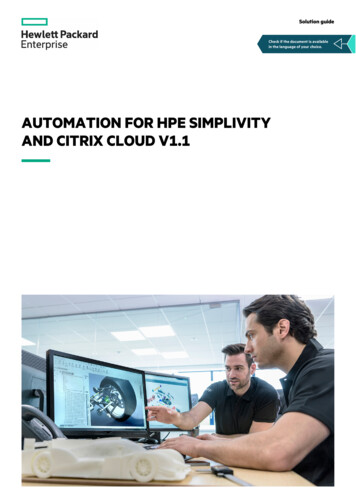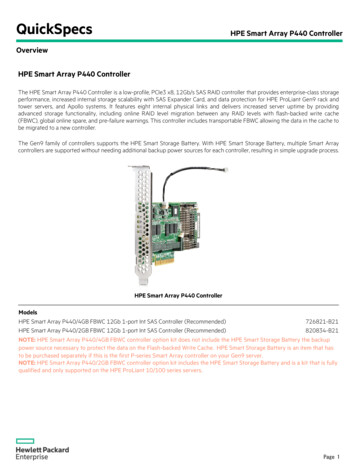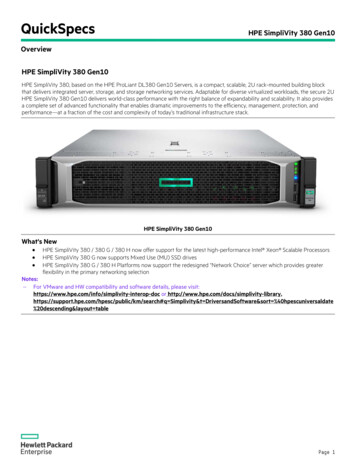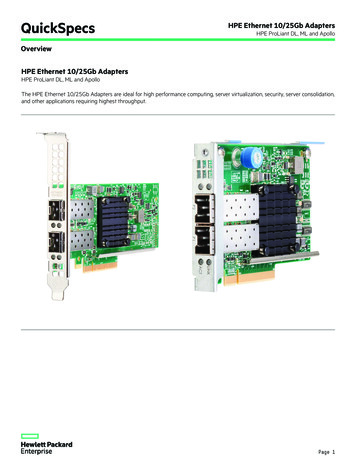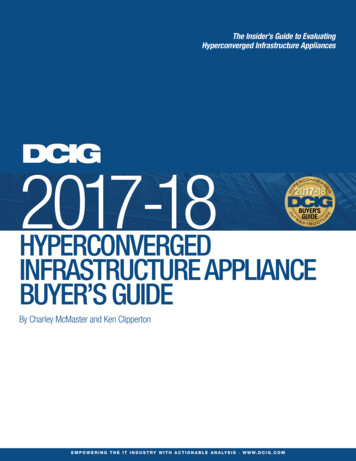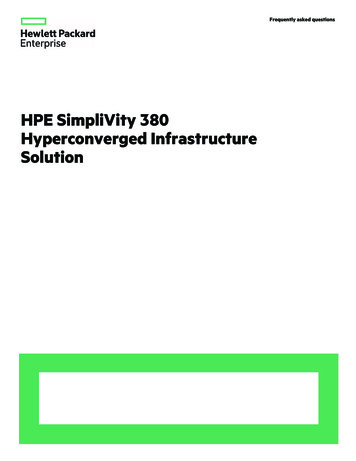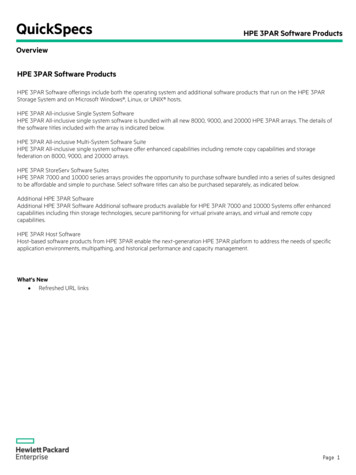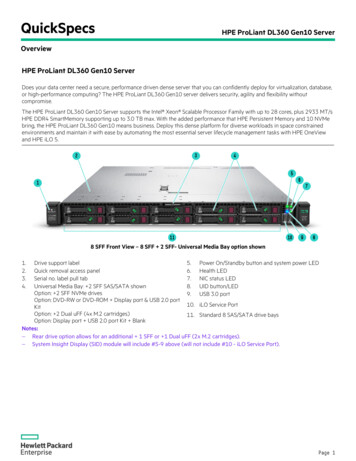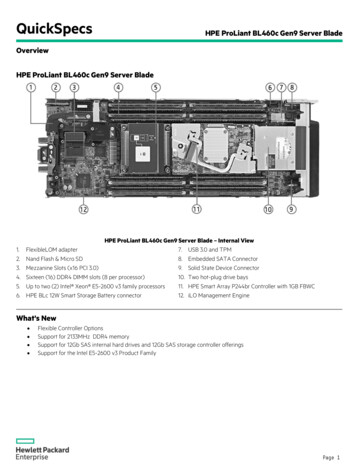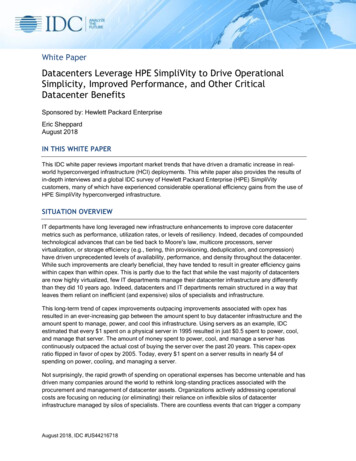
Transcription
White PaperDatacenters Leverage HPE SimpliVity to Drive OperationalSimplicity, Improved Performance, and Other CriticalDatacenter BenefitsSponsored by: Hewlett Packard EnterpriseEric SheppardAugust 2018IN THIS WHITE PAPERThis IDC white paper reviews important market trends that have driven a dramatic increase in realworld hyperconverged infrastructure (HCI) deployments. This white paper also provides the results ofin-depth interviews and a global IDC survey of Hewlett Packard Enterprise (HPE) SimpliVitycustomers, many of which have experienced considerable operational efficiency gains from the use ofHPE SimpliVity hyperconverged infrastructure.SITUATION OVERVIEWIT departments have long leveraged new infrastructure enhancements to improve core datacentermetrics such as performance, utilization rates, or levels of resiliency. Indeed, decades of compoundedtechnological advances that can be tied back to Moore's law, multicore processors, servervirtualization, or storage efficiency (e.g., tiering, thin provisioning, deduplication, and compression)have driven unprecedented levels of availability, performance, and density throughout the datacenter.While such improvements are clearly beneficial, they have tended to result in greater efficiency gainswithin capex than within opex. This is partly due to the fact that while the vast majority of datacentersare now highly virtualized, few IT departments manage their datacenter infrastructure any differentlythan they did 10 years ago. Indeed, datacenters and IT departments remain structured in a way thatleaves them reliant on inefficient (and expensive) silos of specialists and infrastructure.This long-term trend of capex improvements outpacing improvements associated with opex hasresulted in an ever-increasing gap between the amount spent to buy datacenter infrastructure and theamount spent to manage, power, and cool this infrastructure. Using servers as an example, IDCestimated that every 1 spent on a physical server in 1995 resulted in just 0.5 spent to power, cool,and manage that server. The amount of money spent to power, cool, and manage a server hascontinuously outpaced the actual cost of buying the server over the past 20 years. This capex-opexratio flipped in favor of opex by 2005. Today, every 1 spent on a server results in nearly 4 ofspending on power, cooling, and managing a server.Not surprisingly, the rapid growth of spending on operational expenses has become untenable and hasdriven many companies around the world to rethink long-standing practices associated with theprocurement and management of datacenter assets. Organizations actively addressing operationalcosts are focusing on reducing (or eliminating) their reliance on inflexible silos of datacenterinfrastructure managed by silos of specialists. There are countless events that can trigger a companyAugust 2018, IDC #US44216718
to begin such transformations, including deployment of new applications, private cloud initiatives, andtechnology refresh. One common event has been related to a global drive to incorporate 3rd Platformapplications (which can be grouped into four broad categories of social, mobile, cloud, and analytics)into the company's portfolio of workloads. 3rd Platform applications require new levels of scale,automation, and agility that do not align well with the practice of independently buying and managingdiscrete datacenter resources.Enter Converged and Hyperconverged SystemsIt's been more than five years since organizations began looking into converged systems to help dealwith these important and often-transformational datacenter changes. While the architecture of theconverged system has advanced over the years, its goal remains very similar. Specifically, convergedsystems provide a tight integration between core datacenter infrastructure (storage, compute, andnetworking) while offering centralized management and increased levels of automation.Broadly speaking, the first generation of converged systems represent a consolidation of disparatedatacenter technologies that can be acquired, deployed, managed, and supported as though theywere a single system. Fundamentally, these systems are differentiated from traditional hardwareplatforms and architectures in that they are designed to be deployed quickly using a modular buildingblock approach to rapidly scale up resources and workloads. While these first-generation convergedsystems are driving vast amounts of waste out of the datacenter, most systems have been built withthe same type of infrastructure that required silos of experts. Further, the average selling prices ofthese systems tend to make them more suitable for companies with larger datacenter budgets.The relatively recent emergence of hyperconverged systems, which IDC considers a new generationof converged systems, is helping deliver many of the proven benefits of early converged systems (e.g.,reducing complexity and inefficiency), but through a clustered, scale-out architecture that is built onx86-based servers. Hyperconverged systems leverage software-defined storage to provide enterprisestorage services through the same x86 server resources that were also used to run hypervisors andapplications. These systems eliminate shared, networked storage systems, thus further convergingstorage and compute resources. In addition to integrating storage and compute functions into a singlenode (or a cluster of nodes, each offering compute and storage functions), all hyperconverged systemsemploy: A distributed file system or an object store that serves as the data organization, management,and access platform A hypervisor that provides workload adjacency, management, and containerization in additionto providing the hardware abstraction layer (with the hypervisor also hosting essentialmanagement software needed to manage the platform) An (optional) Ethernet switch to provide scale-out and/or high-availability capabilitiesSome hyperconverged systems also offer switching and/or networking to bridge the compute andstorage layers together and offer other data services (e.g., data efficiency and data protection) tofurther consolidate and simplify infrastructure elements in the datacenter.HPE OverviewHPE is a technology company with a comprehensive portfolio ranging from cloud to the datacenter toworkplace applications. HPE technology and services help customers around the world make IT moreefficient, more productive, and more secure. 2018 IDC#US442167182
Early in 2017, HPE acquired SimpliVity, and it now offers HPE SimpliVity hyperconverged systems,complete hardware and software solutions that are designed, built, and supported by HPE. Theturnkey hyperconverged infrastructure platforms are made up of HPE SimpliVity software on HPE'sProLiant DL380 and Apollo 2600 compute platforms. Customer interviews and the survey referencedin this white paper were conducted with customers that have both HPE SimpliVity systems and legacySimpliVity systems in their datacenter.The HPE SimpliVity hyperconverged technology enables organizations to simplify IT. Clusteringmultiple infrastructure units forms a shared resource pool and delivers high availability, mobility, andefficient scaling of performance and capacity.The HPE SimpliVity hyperconverged infrastructure combines compute, storage services, and networkplatform in addition to traditional IT functions, including WAN optimization, unified global virtualmachine (VM)–centric management, data protection, cloud integration, primary storage deduplication,backup deduplication, caching, and global scale-out: Data efficiency. Fine-grained deduplication and compression are conducted on all data, in realtime and always at the point data is created. This is done to ensure that the data remainsdeduplicated and compressed throughout its life cycle. All HPE SimpliVity systems are globallyaware of the compressed and deduplicated data — whether that data is in multiple systems,datacenters, geographies, or public clouds running HPE SimpliVity's software stack. WAN optimization. WAN optimization ensures that data transferred between sites or from asite to the cloud is moved in an efficient manner (this is especially helpful in ROBO scenariosor in situations with poor link latencies). Enhanced data protection. Built-in data protection includes tunable recovery point objectives(RPO) on a per-VM basis, enabling automated, high-frequency backup and replication of VMsto any HPE SimpliVity hyperconverged infrastructure node in a federation. The federation is acollection of nodes managed across multiple sites through a single administrative interfaceand common APIs. Global scale-out. As HPE SimpliVity systems can be added simply and efficiently in local orremote datacenters, they instantly become members of the global federation. Unified global management. HPE SimpliVity systems' resources, policies, and workloads aremanaged via VMware vCenter, facilitating movement of data and VMs across HPE SimpliVityhyperconverged infrastructure units and datacenters without a need to configure IP addresses,controllers, LUNs, and so forth. VM centricity. The HPE SimpliVity system is designed around the logical unit of a VM. Thismeans that all management, policies, commands, and information are provided on a per-VMbasis. In addition, when a backup is performed for a VM, it does not include the other VMs thatshare a given data store. Caching and tiering. To accelerate read performance and assist with read spikes and other I/Obursts, HPE uses caching and tiering. Openness to existing legacy servers. Non-hyperconverged systems running VMs can beconnected to hyperconverged nodes and resident VMs in the federation as a means for usingthe shared storage resources and services and/or enabling the simple migration of data andVMs from existing servers to the federation. The HPE OmniStack Accelerator card. This PCIe module is responsible for all intensivealgorithm processing in each HPE SimpliVity 380 hyperconverged infrastructure node andensures that the deduplication and compression can run in real time with no impact on 2018 IDC#US442167183
performance. HPE also offers a software-optimized version of the HPE SimpliVity solution forspace-constrained environments.The HPE SimpliVity Data Virtualization Platform is the underlying technology within thesehyperconverged infrastructure systems — an assimilated IT infrastructure platform solution that can runon dedicated hardware and on private, public, and hybrid clouds. The HPE SimpliVity DataVirtualization Platform includes a data architecture in which data is deduplicated and compressed atinception in very small data elements in a globally coherent manner — across nodes, datacenters,geographies, and clouds.INSIGHTS INTO CURRENT HPE SIMPLIVITY CUSTOMERSThe sections that follow provide insights into a sample of HPE SimpliVity customers. This informationcomes from two sources: An IDC web survey of 83 end users that have purchased and deployed HPE SimpliVitysolutions. Survey results were completed during the second quarter of 2018 by companieslocated in all major regions around the world. North America accounted for 55% of therespondents, followed by 39% in EMEA and 9% in Asia/Pacific. In-depth phone interviews with three HPE customers that are currently running HPE SimpliVitysolutions in production environments. Each interview was one hour long and was conductedby IDC during the second quarter of 2018.Survey ResultsFigure 1 provides an indication of how broadly HPE SimpliVity hyperconverged solutions are usedwithin survey respondents' production workloads. On average, respondents (i.e., HPE SimpliVitycustomers) are currently running 71% of their production workloads on HPE SimpliVity systems. Thisis up from 59% of their production workloads running on HPE SimpliVity systems just 12 months prior.A look at company sizes tells us that respondents with fewer employees currently run a much largershare of production workloads than their larger counterparts. On average, respondents with fewer than500 employees currently leverage HPE SimpliVity systems for 81% of their production workloads,whereas respondents with 500 employees run 64% of production workloads on HPE SimpliVitysystems. The average share of customer production workloads on HPE SimpliVity systems isexpected to increase again over the next 12 months, but at a more moderate rate (76% of total). 2018 IDC#US442167184
FIGURE 1Share of Total Production Workloads Running on HPE SimpliVityQ.Please estimate the percentage of your organization's total production workloads running onHPE SimpliVity hyperconverged infrastructure 12 months ago, today, and 12 months from now.All respondents 500 employees500 employees 2 datacenters2 datacenters02012 months agoTodayNext 12 months4060(Mean score)80100n 83Source: IDC, 2018Figure 2 offers insight into the types of workloads currently running on HPE SimpliVity systems. Themost common workload type was traditional IT infrastructure (i.e., file/print, systems management,network management, and security), followed by business applications (e.g., ERP, CRM, financialmanagement software) and collaborative applications. These workloads were followed by applicationdevelopment and testing and web serving, which also returned similar shares of total responses.These rankings resemble past IDC surveys that have explored the types of existing applicationsrunning on hyperconverged systems; results of these surveys tend to place IT infrastructure,application/software development, and collaborative applications among the most common workloads. 2018 IDC#US442167185
FIGURE 2Workloads Running on HPE SimpliVity, 2018Q.Which of the following workloads in your environment today are deployed on HPE SimpliVityhyperconverged infrastructure?Traditional IT infrastructure (e.g., videotranscoding, networking, security, systemsmanagement)Business applications (e.g., ERM, CRM, financialmanagement, HCM)Collaborative apps (e.g., conferencing, instantmessaging, email, social networks, file sharing)Application development and testingWeb servingStructured data management (e.g., RDBMS,NRDBMS, database development and management)Content applications (e.g., content management,authoring and publishing, enterprise portals)Structured data analytics (e.g., end-user query,predictive analytics, GIS)Unstructured content/data analytics (e.g., contentanalytics, search, cognitive platforms, Hadoop)Virtual desktop infrastructure (VDI)Engineering/technical applications (e.g.,CAD/CAE/CAM, other technical)Media streaming01020304050607080(%)n 83 (total responses 505)Source: IDC, 2018Figures 3 and 4 explore the challenges respondents sought to address when deploying HPESimpliVity. The figures list the "primary" challenges as well as "all challenges" respondents werelooking to address when deploying HPE SimpliVity. The results for primary challenges reflect just onechoice per respondent, whereas the results for all challenges reflect multiple responses. The primary 2018 IDC#US442167186
challenge HPE SimpliVity customers were looking to address was infrastructure migration and/ortechnology refresh. This challenge represented 28.9% of all respondents, which was more than doublethe second most common primary challenge of improving backup and recovery (12%). Although calledout explicitly in this survey, it should be noted that other choices reflected here are often tied to gainsin operational efficiency. One response that stands out among all others for "all challenges" is"improving backup and recovery," which was listed as a challenge by 82% of all respondents. Whileimproving backup and recovery may not be the most common "primary" challenge companies areturning to HPE SimpliVity infrastructure to help solve, it is clear that the vast majority view it as avalued feature.FIGURE 3All Challenges Addressed with HPE SimpliVity DeploymentQ.What is the challenge that your organization sought to address with the use of a HPESimpliVity hyperconverged infrastructure?Improve backup and recoveryInfrastructure migration or refreshImprove operational efficiencyImprove infrastructure utilizationImprove staff productivityDatacenter consolidationScale resources easily and affordablyReduce time to provision infrastructureImprove application performanceReduce capexLower cost of disaster recovery or second sitesConsolidate vendorsOther01020304050(%)60708090n 83 (total responses 567)Source: IDC, 2018 2018 IDC#US442167187
FIGURE 4Primary Challenge Addressed with HPE SimpliVity DeploymentQ.What is the primary challenge that your organization sought to address with the use of a HPESimpliVity hyperconverged infrastructure?Infrastructure migration or refreshImprove backup and recoveryImprove operational efficiencyLower cost of disaster recovery or second sitesDatacenter consolidationReduce capexScale resources easily and affordablyImprove application performanceReduce time to provision infrastructureImprove staff productivityImprove infrastructure utilizationConsolidate vendorsOther051015(%)202530n 83 (total responses 83)Source: IDC, 2018Figure 5 dives deeper into the use of HPE SimpliVity data protection features and their impact onexisting, established offerings. 94% of the surveyed customers are currently using the built-in dataprotection features. The impact of HPE SimpliVity data protection features frequently results inreduced use of existing data protection software. Indeed, 55% of survey respondents retired theirexisting third-party backup or replication software in lieu of HPE SimpliVity data protection features. 2018 IDC#US442167188
FIGURE 5Data Protection and Disaster Recovery Within HPE SimpliVity EnvironmentsCurrently using built-in backup/recovery featuresHave retired use of third-party backup/replicationsoftwareCurrently using or planning to use HPE's disasterrecovery orchestration softwareCurrently using or planning to use third-partydisaster recovery orchestration software0102030405060708090100(%)n 83Source: IDC, 2018Areas of Realized ImprovementsThis section reviews the improvements realized from the deployment of HPE SimpliVity infrastructure.Rates of improvements are quite high for all the areas listed. The biggest rate of improvementoccurred within backup and recovery or disaster recovery (DR) environments (see Figure 6). Surveyrespondents tell us that, on average, HPE SimpliVity improved their backup or DR environments by55% when compared with their previous environment. This is likely tied to the HPE SimpliVityplatform's simplified approach to backup and recovery and disaster recovery, the platform's ability tomeet stringent recovery point and recovery time objectives, and a reduction in the use of third-partysoftware. It's also likely tied to global deduplication and replication features, which have allowed manycustomers to implement disaster recovery more cost efficiently than prior solutions. This area wasclosely followed by improved storage utilization (40.4% improvement), which is likely due to HPESimpliVity's global deduplication and compression technology. Other noteworthy customerimprovements include IT and application provisioning times (38.7%) and improved applicationperformance (29%). 2018 IDC#US442167189
FIGURE 6Average Improvements Driven by HPE SimpliVityQ.What percentage improvement has your organization experienced from the use of HPESimpliVity hyperconverged infrastructure in any of these areas?Improvements in backup and recovery and/ordisaster recoveryImproved storage utilizationFaster infrastructure and application provisioningAbility to easily scaleReduced downtime and improved applicationavailabilityImproved utilization of compute resourcesImproved IT staff productivity/reduced trainingrequiredImproved application performanceReduced cost of datacenter facilities, power, andcoolingFewer technology refresh cyclesReduced capital spendingFaster time to market0102030(%)405060n 83 (total responses 314)Source: IDC, 2018Figure 7 provides the results from the portion of the survey that asked respondents to allocate howmuch time IT staff tend to spend on typical projects or tasks. The results represent a "before and after"view for HPE SimpliVity customers. The most striking change comes within the highly coveted timespent on innovation and new projects. HPE SimpliVity customers spent 14.8% of their time oninnovation and new projects before deploying HPE SimpliVity compared with 28.1% of their time oninnovation and new projects after deploying HPE SimpliVity, a gain of 91%. Broadly speaking, this wasmade possible from time savings associated with managing fewer infrastructure components tosupport respondents' virtualized workloads, simplified backup/recovery and disaster recovery (animprovement of 39%), and less time spent troubleshooting. In addition, respondents reported seeing a25% improvement in time spent provisioning, patching, and configuration management and a 19%improvement in monitoring, troubleshooting, and remediation. It should be noted that these resultswere compiled prior to HPE's acquisition of software-defined networking (SDN) company, Plexxi. It isreasonable to expect this acquisition to, in time, lead to the integration of Plexxi's SDN capabilities intoan HPE SimpliVity hyperconverged solution. Such a solution could take these powerful results evenfurther by removing the cost and complexities associated with datacenter networks. 2018 IDC#US4421671810
FIGURE 7Impact of HPE SimpliVity on Time Spent on Select TasksQ.Considering the following mix of tasks, over a given week, what percentage of total ITadministrator/operations staff time is spent on the following six tasks before and after HPESimpliVity was 717.014.8011.411.010.6Prior to HPE SimpliVityAfter HPE SimpliVityInnovation and new projectsMonitoring, troubleshooting, and remediationNew service request and approvalProvisioning, patching, and configuration managementBackup/recovery and disaster recoveryVendor and internal meetingsn 83Source: IDC, 2018Figure 8 identifies where survey respondents achieve budget savings by deploying the HPE SimpliVityplatform. Hardware and software capital expenses were the most common source of budget savings(39.8%), with costs related to datacenter facilities (e.g., power, cooling, datacenter floor space)surfacing as the second most common source of budget savings (24.1%). Figure 9 reveals that HPESimpliVity customers were able to shift investments toward new technology projects and purchasesfrom 48% to 59% of their IT budget. This represents a 23% increase over their pre-HPE SimpliVityenvironments. 2018 IDC#US4421671811
FIGURE 8Source of Savings Driven by HPE SimpliVityQ.On which of the following budget line items have you achieved savings by deploying HPESimpliVity hyperconverged infrastructure?Hardware and software capital expensesDatacenter facilities (e.g., floor space, power,cooling)Internal staff, outsourcing, professionalservices, and consultingAnnual maintenance feesOther05101520(%)25303540n 83Source: IDC, 2018FIGURE 9IT Budget Spending on New Projects Versus Maintaining Existing Infrastructure:Before and After Deployment of HPE SimpliVityQ.Approximately what percentage of your organization's IT budget will be spent on newtechnology projects and purchases, as opposed to the percentage of budget spent onmaintaining existing infrastructure?Before HPE SimpliVity52After HPE SimpliVity484102059406080100(%)MaintainingNew projectsn 83Source: IDC, 2018 2018 IDC#US4421671812
Highlights from In-Depth Interviews with Three HPE SimpliVity CustomersAs previously noted, IDC interviewed three HPE SimpliVity customers to better understand how theyuse the technology and how they are benefiting from HPE SimpliVity solutions.Interview 1: A Hospitality Company Operating More than 10 Seasonal Resortsin North AmericaIDC interviewed a company in the hospitality industry that primarily operates more than 10 seasonalresorts. The company has an IT staff of nearly 100 people that are complemented by 40 external ITprofessionals. The company owns 150 servers (70% of which are virtualized) that are located inmultiple datacenters. The company runs industry-specific workloads that support operations and sales.In total, the company runs 25 business applications that include on-premise software and SaaSapplications.As an organization that has grown rapidly through acquisition, the company had disparate systemsand a datacenter that was nearing end of life. HCI was seen as a way to simplify IT management in themost cost-effective way. The company initially deployed HPE SimpliVity as the foundationalinfrastructure for its new datacenter. The company initially implemented two nodes of HPE SimpliVityand expanded rapidly from there. It currently runs three SimpliVity clusters for a total of 15 nodes. Twoof these clusters are located at its primary datacenter, and the third represents the first clusterdeployed at one of its resorts.The company cites IT simplification and cost-effectiveness as among the primary drivers of HCI. As acompany that has grown through acquisition, there were multiple tools for managing infrastructure foractivities such as IT ticketing, backup, and system monitoring. Standardizing infrastructure andmanagement tools was one of the benefits that HCI could deliver. The company has subsequentlydeployed HPE SimpliVity at one of its resorts. The operational simplicity and centralized managementallow local IT staff to spend their time supporting local users and site-specific infrastructure(networking, WiFi, resort applications, etc.) rather than spending time on infrastructure-specific taskssuch as racking and stacking, managing storage, managing networking, and backups. HPE SimpliVityenables the company to centralize management of SimpliVity clusters. The company intends to roll outadditional HCI clusters at each resort as installed servers and storage enter end of life and requirerefreshing.The following are highlights that were brought up during the interview, with select quotes from thecustomer: Investment in HPE SimpliVity technology resulted in significant benefits to backup processesand staff efficiency, with time spent on managing infrastructure reduced by 25%. "Looking forward, HCI will be the infrastructure used for all resorts and our datacenter." "We will soon be at a point where the data in our datacenter will strictly be on SimpliVity." "We hardly provision storage anymore." "We are trying to phase out existing backup systems. That's the goal . to drive the backupheadaches out and just use SimpliVity . to take our existing [backup] software into an archiverole." 2018 IDC#US4421671813
Interview 2: A Nonprofit Biomedical Research InstitutionIDC interviewed a nonprofit biomedical research institution that has 20 nodes of HPE SimpliVitysystems spread across six locations and seven clusters. The HPE SimpliVity deployment also includesapproximately 500 virtual desktops, more than 150 virtual servers, and approximately 200TB ofSimpliVity capacity. The organization has approximately 2,000 employees and 100 IT staff members.The company has a large amount of HPC infrastructure, but this conversation focused only on itsbusiness applications. The infrastructure supporting its business applications includes 75 servers (ofwhich 99% are virtualized), 1PB of enterprise storage capacity, and 1,400 virtual machines. At the timethat IDC conducted the interview, the organization had very limited use of public cloud.Initially, the organization deployed HPE SimpliVity for a VDI project designed to create a betterplatform to keep an accurate inventory of lab mice. The goal was to connect the people who care formice with the ERP system used to track inventory of the mice sold. The organization could potentiallylose millions in revenue if the system went down or simply didn't have a way to accurately keep trackof valuable inventory.The organization investigated other HCI offerings and opted to go with HPE SimpliVity because of itshigh performance and tight integration with VMware vCenter. Importantly, the organization found thatcompeting HCI solutions required changes and continual tuning to address performance, which wasneedlessly complex and therefore ran contrary to HCI's promise of simplicity.HPE SimpliVity was also brought in to reduce the latency of the organization's SQL Serverenvironment; SQL Server was moved from a siloed blade and storage infrastructure to the HPESimpliVity all-flash HCI. The organization was pleased with the results of this migration and theresulting performance. It then deployed HPE SimpliVity for its ERP application, which helped reducethe complexity of the infrastructure supporting critical information such as inventory and greatlyimprove application performance. The organization is currently running its data warehouse on HPESimpliVity, which has driven query response time down to just a few minutes. This was instrumental tothe development team's successful shift to an agile development workflow.HPE SimpliVity helped drive down the complexity, risk, and cost related to the organization's dataprotection environment. It has reduced the time to backup all local data from 7 hours to just 45minutes. HPE SimpliVity is also deployed in a small cluster at a colocation for low-cost and easy-tomanage disaster recovery. DR remains an ongoing project, but the company stated that HPESimpliVity has initially reduced complete recovery time from as many as 30 days to just 24 hours. Thecompany has a goal of getting this down to less than an hour using HPE SimpliVity.The following are highlights that were brought up during the interview, with select quotes from thecustomer: "We are overworked and understaffed, so how can we find a way for the staff to get moredone? I see HCI as a way to do that. SimpliVi
HPE SimpliVity systems' resources, policies, and workloads are managed via VMware vCenter, facilitating movement of data and VMs across HPE SimpliVity . The HPE OmniStack Accelerator card. This PCIe module is responsible for all intensive algorithm processing in each HPE SimpliVity 380 hyperconverged infrastructure node and
